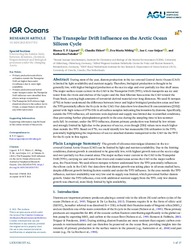The Transpolar Drift Influence on the Arctic Ocean Silicon Cycle
DOI: https://doi.org/10.1029/2021JC017352
Persistent URL: http://resolver.sub.uni-goettingen.de/purl?gldocs-11858/9744
Persistent URL: http://resolver.sub.uni-goettingen.de/purl?gldocs-11858/9744
Liguori, Bianca T. P.; Ehlert, Claudia; Nöthig, Eva‐Maria; van Ooijen, Jan C.; Pahnke, Katharina, 2021: The Transpolar Drift Influence on the Arctic Ocean Silicon Cycle. In: Journal of Geophysical Research: Oceans, Band 126, 11, DOI: 10.1029/2021JC017352.
 |
Dokument öffnen: |
During most of the year, diatom production in the ice‐covered Central Arctic Ocean (CAO) is limited by light availability and nutrient supply. Therefore, biological production is thought to be generally low, with higher biological production at the sea ice edge and over partially ice‐free shelf areas. The major surface ocean current in the CAO is the Transpolar Drift (TPD), which transports sea ice and water from the rivers and shelves of the Laptev and the East Siberian Seas across the CAO toward the Fram Strait, carrying high amounts of terrestrial‐derived material over long distances. We used Si isotopes (δ30Si) to better understand the difference between lower and higher biological production areas and how the TPD potentially affects the Si cycle in the CAO. Our data show low dissolved Si concentrations ([DSi]) paired with high values of δ30Si‐DSi in all surface samples indicating fractionation by diatoms. Specifically, outside the TPD influence, all nutrients were depleted and supply was limited due to stratified conditions, thus preventing further phytoplankton growth in the area during the sampling time in late summer‐early fall. In contrast, under the TPD influence, diatom primary production was limited by low nitrate and strongly limited by light due to the presence of sea ice, even though [DSi] values were much higher than outside the TPD. Based on δ30Si, we could identify low but measurable DSi utilization in the TPD, potentially highlighting the importance of sea ice‐attached diatoms transported to the CAO via the TPD for the Si cycle in this region. Plain Language Summary:
The growth of siliceous microalgae (diatoms) in the ice‐covered Central Arctic Ocean (CAO) can be limited by light and nutrient availability. Due to the limiting conditions, diatom growth is considered to be generally low, with highest growth rates at the sea ice edge and over partially ice‐free coastal areas. The major surface water current in the CAO is the Transpolar Drift (TPD), carrying ice and water from rivers and coastal areas across the CAO to the major outflow area, the Fram Strait. We used silicon isotopes to better understand how the TPD potentially influences the silicon cycle in the CAO. Our data show that diatom growth was taking place in all areas studied here, despite different growth limiting factors outside and under the TPD influence. In the area outside the TPD influence, nutrient availability was very low and its supply was limited, which prevented further diatom growth. Under the TPD influence, even with additional nutrient supply from the TPD, only low diatom growth was observed, most likely limited by light availability. Key Points:
Primary production and silicon utilization outside the Transpolar Drift are higher than under its influence due to more light availability.
Primary production and lateral water transport under the Transpolar Drift influence were identified from silicon isotope composition.
The Transpolar Drift delivers high dissolved silicon to the surface Arctic Ocean, a unique feature not seen in any other open ocean.
Statistik:
ZugriffsstatistikSammlung:
- Geographie, Hydrologie [454]
This is an open access article under the terms of the Creative Commons Attribution‐NonCommercial‐NoDerivs License, which permits use and distribution in any medium, provided the original work is properly cited, the use is non‐commercial and no modifications or adaptations are made.

